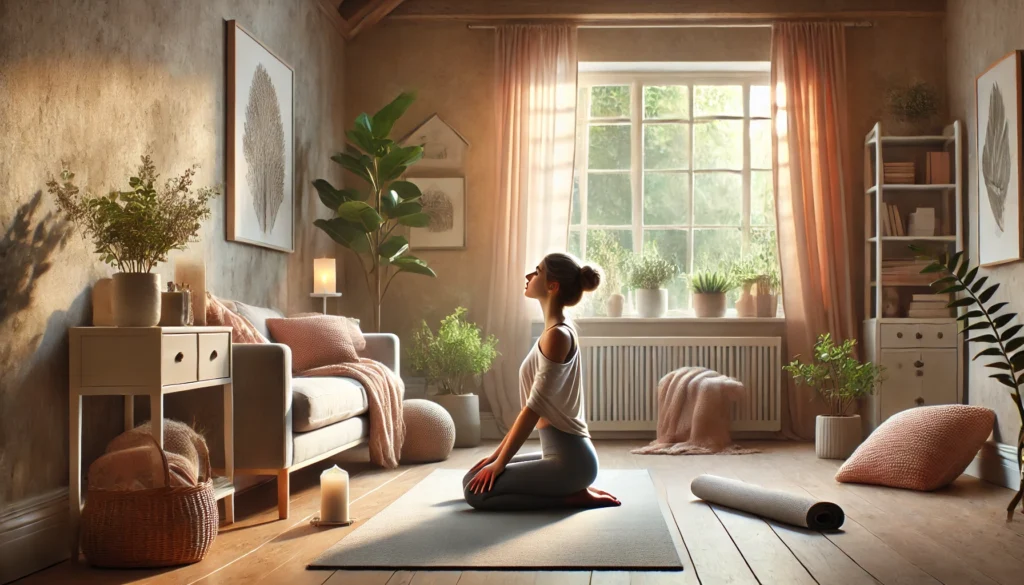In today’s hyperconnected, fast-paced world, stress and anxiety have become unwelcome companions for millions. Whether spurred by professional pressures, personal challenges, or the relentless demands of modern life, these mental burdens often leave individuals searching for effective and sustainable ways to find peace. Fortunately, decades of research in psychology, neuroscience, and holistic medicine have yielded a wide array of calming techniques that not only soothe the mind in the moment but also build long-term resilience. This article explores the most effective, evidence-based relaxation strategies to help readers understand how to calm themselves down when stressed, and to cultivate mental and emotional equilibrium in their daily lives.
You may also like: Natural Remedies for Bipolar Disorder: Holistic Approaches for Lasting Relief
Understanding the Science of Stress and Anxiety
To appreciate the importance of relaxation techniques for stress and anxiety, it is crucial to understand the physiological and psychological dynamics underlying these states. Stress activates the body’s sympathetic nervous system, triggering the so-called “fight-or-flight” response. This process floods the bloodstream with adrenaline and cortisol, raising heart rate and blood pressure while heightening alertness. While this response can be life-saving in truly threatening situations, chronic activation due to everyday stressors can impair immune function, disrupt sleep, and contribute to long-term health problems such as cardiovascular disease, digestive disorders, and cognitive decline.
Anxiety, though closely related to stress, differs in its mechanism and presentation. Often rooted in excessive worry or fear, anxiety can persist even in the absence of an immediate external threat. It is associated with heightened activity in the amygdala, the brain’s emotional processing center, and a diminished ability of the prefrontal cortex to regulate emotional responses. This imbalance often manifests in physical symptoms like muscle tension, rapid breathing, gastrointestinal discomfort, and chronic fatigue. Recognizing these patterns helps lay the foundation for adopting targeted stress reduction exercises and anxiety calming techniques that address both the body and the mind.
The Importance of Integrating Mind-Body Practices
Modern mental health strategies increasingly emphasize the inseparability of mental and physical well-being. Relaxation exercises for anxiety work by interrupting the body’s stress response and activating the parasympathetic nervous system, responsible for rest, digestion, and recovery. Techniques like diaphragmatic breathing, progressive muscle relaxation, and meditation can elicit this response, resulting in a measurable decrease in cortisol levels, heart rate, and muscle tension. Moreover, these practices cultivate interoceptive awareness—the ability to sense internal bodily states—which enhances emotional regulation and self-awareness.
Integrating mind-body practices into daily routines offers more than momentary relief. Over time, repeated engagement with these self relaxation techniques leads to neuroplastic changes in the brain. Research has shown that consistent meditation can thicken the prefrontal cortex, strengthen connections between brain regions involved in emotional regulation, and reduce activity in the amygdala. This not only diminishes the intensity of future anxiety responses but also fosters a general sense of well-being and groundedness. As a result, these calming exercises for anxiety do not merely alleviate symptoms; they help rewire the brain for resilience.
Breathwork: The Gateway to Calm
Breathing is a unique physiological function in that it occurs automatically yet can also be consciously controlled. This dual nature makes it an ideal anchor for relaxation techniques for stress and anxiety. Controlled breathing, especially diaphragmatic or abdominal breathing, slows the heart rate and promotes feelings of safety. When practiced consistently, it strengthens the vagus nerve, a key component of the parasympathetic nervous system, enhancing the body’s ability to shift out of stress mode.
Box breathing, also known as square breathing, involves inhaling for four counts, holding for four, exhaling for four, and holding again for four. This rhythmic pattern regulates autonomic function and grounds attention in the present moment. Another effective method is 4-7-8 breathing, where the inhale lasts four seconds, the hold seven, and the exhale eight. This technique extends the exhalation phase, which has been shown to reduce sympathetic arousal. As such, these methods serve as practical tools for anyone wondering how to calm yourself down when stressed.

Progressive Muscle Relaxation: Releasing Physical Tension
Progressive muscle relaxation (PMR) is a classic method for promoting deep relaxation through sequential tensing and releasing of muscle groups. This practice heightens bodily awareness and helps individuals recognize where they carry stress physically—often the shoulders, neck, or jaw. As they learn to release this tension voluntarily, a feedback loop is established in which physical relaxation supports emotional calm.
PMR has been shown to reduce symptoms of generalized anxiety disorder, insomnia, and tension headaches. It can be particularly beneficial for those who experience stress somatically and find verbal or cognitive techniques less effective. Regular practice enhances body awareness and helps individuals distinguish between a state of tension and one of true relaxation. When incorporated consistently, it becomes one of the most powerful relaxation exercises for stress.
Mindfulness and Meditation: Training the Mind
Mindfulness-based interventions have become central pillars in modern mental health treatment. Rooted in ancient contemplative traditions and validated by neuroscience, mindfulness meditation involves paying nonjudgmental attention to present-moment experiences, whether bodily sensations, emotions, or thoughts. This practice strengthens the brain’s ability to observe rather than react, fostering a space between stimulus and response where conscious choice becomes possible.
Studies have shown that just eight weeks of mindfulness training can lead to measurable changes in brain structure and function. It reduces activity in the default mode network, often associated with rumination and self-referential thinking, while enhancing connectivity in networks related to attention and emotional regulation. For individuals seeking long-term strategies to manage stress and anxiety, mindfulness offers a deeply empowering approach. It is among the most evidence-based relaxation methods for stress and anxiety, with robust data supporting its efficacy in diverse populations.
Guided Imagery and Visualization: Harnessing the Power of the Mind’s Eye
Guided imagery leverages the mind’s capacity to simulate soothing environments and experiences. By mentally transporting oneself to a peaceful beach, forest, or mountaintop, the nervous system responds as if the body were physically present in that environment. This practice reduces heart rate, blood pressure, and muscle tension, while increasing the production of serotonin and endorphins.
Visualization is also useful for reframing stressful situations. Athletes and performers have long used mental rehearsal to enhance confidence and reduce performance anxiety. Similarly, individuals facing exams, job interviews, or public speaking can benefit from visualizing themselves responding calmly and competently. These mental relaxation techniques are easily accessible and adaptable, making them valuable tools for anyone exploring how to calm yourself down.
Relaxation Techniques for Anxiety Attacks: Grounding Strategies That Soothe the Nervous System
For those who suffer from anxiety attacks, the intensity of symptoms can feel overwhelming and even frightening. Racing thoughts, tightness in the chest, shortness of breath, and a sense of losing control are hallmark experiences that can make it difficult to function in the moment. Fortunately, targeted relaxation techniques for anxiety attacks can help de-escalate these acute responses. The key lies in rapidly engaging the body’s calming mechanisms while gently redirecting the mind’s focus.
Grounding techniques are particularly effective during the peak of an anxiety episode. These involve bringing one’s awareness back to the present moment by engaging the five senses. For example, touching a textured object, naming five things in the environment, or listening closely to ambient sounds can interrupt the cycle of escalating panic. These strategies not only distract from distressing thoughts but also help reinforce a sense of safety and control. In this context, grounding serves as both a psychological anchor and a neurological cue to downshift from a hyperaroused state.
Another effective method is paced breathing with tactile feedback. Placing one hand on the chest and the other on the abdomen allows individuals to track their breath and regulate it consciously. Breathing slowly and deeply into the diaphragm for several cycles sends a direct signal to the brain that the threat has passed, promoting physiological calm. This combination of physical contact and mindful breathing enhances the impact of traditional calming exercises for anxiety.
Cognitive reframing can also be helpful during anxiety attacks, especially when practiced beforehand and used in tandem with other relaxation strategies for stress. Reminding oneself that the episode is temporary, and that anxiety’s physical symptoms are not dangerous, can reduce fear and prevent a spiraling effect. Over time, the brain learns to reinterpret these bodily signals not as threats but as manageable experiences. This process of cognitive reappraisal, reinforced by consistent practice of relaxation techniques for anxiety attacks, fosters long-term resilience.

Frequently Asked Questions: Proven Relaxation Techniques for Stress and Anxiety
1. How can I use calming techniques in high-pressure social situations without drawing attention to myself?
In socially intense moments, subtle calming techniques can be incredibly effective. For example, you can practice controlled breathing by lengthening your exhales slightly longer than your inhales, which activates the parasympathetic nervous system without any outward sign. Another technique involves discreetly pressing your fingertips together while focusing on their texture, a form of tactile grounding that centers your mind. Internal affirmations, such as silently repeating a calming phrase, can also be surprisingly powerful. These are quiet yet impactful ways to calm yourself down when stressed in public settings without attracting unwanted attention.
2. Are there any innovative or lesser-known relaxation exercises for anxiety gaining attention in clinical research?
Yes, several emerging approaches are showing promise in preliminary studies. One such method is havening, which involves gentle self-touch techniques paired with positive mental imagery to disrupt distressing emotional patterns. Another involves bilateral stimulation, often used in EMDR therapy, where rhythmically moving the eyes or tapping alternately on each side of the body helps reduce anxiety intensity. These practices are being explored as new forms of anxiety calming techniques that engage both mind and body. As research continues, we may see these incorporated into broader relaxation strategies for stress and anxiety management.
3. How do different environments impact the effectiveness of relaxation methods for stress and anxiety?
Environmental context plays a major role in how well relaxation techniques work. Natural environments, especially those with elements like water, greenery, or birdsong, can enhance the effectiveness of calming exercises for anxiety by reducing cognitive load and inducing a sense of safety. Urban noise and artificial lighting, on the other hand, may diminish the impact of otherwise effective stress exercises. Even the presence of certain colors, such as blues and greens, has been linked to reduced arousal levels. Choosing or modifying your environment can amplify the benefits of self relaxation techniques considerably.
4. What are some effective ways to calm down that don’t rely on traditional meditation or breathwork?
While meditation and breathwork are foundational, some individuals find relief through less conventional ways to calm down. For instance, sensory deprivation using floatation tanks can induce deep mental relaxation techniques by minimizing external input. Gentle rocking or swaying motions—either in a chair or even while standing—stimulate vestibular soothing responses. Another strategy is expressive writing, where articulating emotions freely in a journal helps reduce internal tension. These options provide meaningful alternatives for those who struggle with more structured relaxation exercises for stress.
5. How do relaxation techniques for anxiety attacks differ from those used for everyday stress?
When it comes to anxiety attacks, the approach needs to be both immediate and deeply grounding. During such moments, techniques that redirect attention—like the 5-4-3-2-1 sensory grounding method—are more appropriate than slower strategies like guided meditation. Relaxation techniques for anxiety attacks should prioritize regaining a sense of control and presence. This contrasts with daily stress exercises, which aim for broader regulation of the nervous system over time. Understanding the difference between these relaxation strategies for stress can help you deploy the right tool for the right moment.
6. Can physical activity be integrated into calming techniques without becoming a workout?
Absolutely. Movement-based calming exercises for anxiety do not have to resemble intense fitness routines. Slow, deliberate activities like tai chi, qigong, and gentle stretching offer a hybrid of mindfulness, breath control, and movement. These are relaxing exercises that ground the body while gently mobilizing stress-held tension. Even a slow walk with focused attention on footfalls and surroundings can act as a moving meditation. These stress reduction exercises are especially helpful for those who find stillness uncomfortable or triggering.
7. How can relaxation tips for stress be adapted for individuals with neurodivergent traits like ADHD or autism?
Individuals with neurodivergence may need modified relaxation techniques for stress and anxiety that respect sensory sensitivities and attention patterns. For instance, rhythmic fidget tools, weighted blankets, or noise-canceling headphones can provide calming sensory input. Instead of silent meditation, guided audio sessions or visual breathing apps may work better for focusing the mind. Structure and predictability also support anxiety relaxation techniques in neurodivergent individuals. Personalized, flexible approaches allow for consistent use of self relaxation techniques in ways that feel natural and supportive.
8. What role does nutrition play in enhancing the effects of relaxation techniques for anxiety?
While not a technique in itself, nutrition significantly influences how well your body responds to calming techniques. A stable blood sugar level helps regulate mood and reduce irritability, making it easier to engage in relaxation exercises for anxiety. Nutrients like magnesium, omega-3 fatty acids, and B vitamins are associated with reduced stress responses. Additionally, staying hydrated supports proper neurological function, enhancing the effects of stress reduction exercises. Therefore, pairing relaxation strategies for stress with sound nutrition offers a more holistic path to calm.
9. Are there specific cultural practices that offer unique relaxation techniques for stress and anxiety?
Many cultural traditions around the world feature unique ways to calm down. Japanese forest bathing, or shinrin-yoku, encourages mindful immersion in nature and has measurable effects on heart rate and cortisol levels. Indigenous communities often integrate storytelling, drumming, or ceremonial dances as communal calming techniques that foster emotional release and connection. South Asian traditions like pranayama breathing and mantra chanting offer deeply rooted relaxation exercises for stress with spiritual and physiological benefits. Exploring these traditions can offer new pathways into mental relaxation techniques that resonate with individual values and histories.
10. How can I make calming exercises for anxiety a consistent habit in a busy lifestyle?
The key to integrating anxiety calming techniques into a hectic schedule is microdosing relaxation throughout the day. This involves embedding small, purposeful moments of calm during transitions—like breathing deeply while your coffee brews or stretching for two minutes before meetings. Using habit-stacking, where you pair calm down exercises with existing routines (e.g., brushing teeth or checking emails), builds consistency effortlessly. Mobile apps and reminders can also prompt regular practice without feeling intrusive. Over time, these brief, consistent moments become a seamless part of your daily relaxation methods for stress and anxiety management.

Importantly, individuals who experience frequent or intense anxiety episodes should consider integrating preventive practices into their daily lives. Regular use of relaxation exercises for anxiety—such as yoga, meditation, and nature exposure—can reduce the baseline level of physiological arousal and make anxiety attacks less frequent or severe. This proactive approach aligns with the broader goal of cultivating inner calm and emotional balance rather than simply reacting to moments of crisis.
stress relief methods, coping strategies for anxiety, emotional regulation techniques, mental wellness practices, soothing practices for the mind, nervous system reset, holistic mental health, cognitive stress management, trauma-informed relaxation, mindfulness for beginners, breath control techniques, neuroplasticity and stress, relaxation response activation, somatic stress relief, calming rituals for adults, therapeutic breathing, anxiety prevention tips, self-soothing tools, body-mind integration, mindful lifestyle habits
Further Reading:
Relaxation Techniques for Mental Wellness
Relaxation Techniques for Stress Relief
Mind and Body Approaches for Stress and Anxiety
Disclaimer
The information contained in this article is provided for general informational purposes only and is not intended to serve as medical, legal, or professional advice. While Health11News strives to present accurate, up-to-date, and reliable content, no warranty or guarantee, expressed or implied, is made regarding the completeness, accuracy, or adequacy of the information provided. Readers are strongly advised to seek the guidance of a qualified healthcare provider or other relevant professionals before acting on any information contained in this article. Health11News, its authors, editors, and contributors expressly disclaim any liability for any damages, losses, or consequences arising directly or indirectly from the use, interpretation, or reliance on any information presented herein. The views and opinions expressed in this article are those of the author(s) and do not necessarily reflect the official policies or positions of Health11News.


